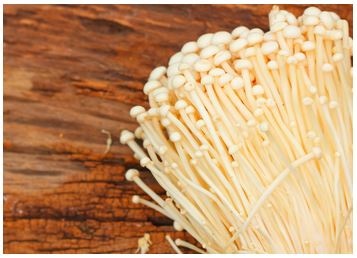Jun 20 2019
LEDs, solar panels, and similar technologies need a cover material that repels dirt, water, and oil and, at the same time, allow a lot of light through.
 (Image credit: University of Pittsburgh)
(Image credit: University of Pittsburgh)
By using innovative flexible materials, these devices can be integrated into a wide range of creative applications like paper, clothes, and curtains.
Now, scientists from the University of Pittsburgh’s Swanson School of Engineering have developed a flexible optical plastic that possesses all of those characteristics, finding inspiration in an unexpected place—the outline of Enoki mushrooms.
The study titled, “Stain-Resistant, Superomniphobic Flexible Optical Plastics Based on Nano-Enoki Mushrooms” has been reported in the Journal of Materials Chemistry A.
The team developed a plastic sheet surface with thin and tall nanostructures featuring bigger tops, similar to an Enoki mushroom. The nanostructures are called nano-enoki polyethylene terephthalate (PET). These structures in the coating render the plastic sheet superomniphobic, repelling an array of liquids and, at the same time, preserving a high level of transparency.
The surface can repel a wide range of liquids, such as milk, water, olive oil, coffee, and ketchup. It also has high haze and high transparency, which means it permits more light to pass through. However, that light is scattered, making it suitable for incorporating with LEDs or solar cells, an when integrated with its durability and flexible, it can perhaps be utilized in wearable technology or flexible lighting.
The key thing with these structures is the shape—it keeps liquid on top of the nanostructure. This is the best in the literature so far in terms of high transparency, high haze and high oil contact angle. We show that substances that usually stain and leave residue behind, like mustard and blood, fall completely off the surface, even after they’ve dried.
Sajad Haghanifar, Study Lead Author and Doctoral Candidate, Industrial Engineering, Swanson School of Engineering, University of Pittsburgh
Videos demonstrate how the dried blood and mustard come off the surface upon tilting the surface.
The lotus leaf is nature’s gold standard in terms of a liquid-repellant and self-cleaning surface. We compared our nano-enoki PET with a lotus leaf and found that ours was better at repelling more kinds of liquids, including olive oil, blood, coffee, and ethylene glycol. The surfaces not only resist staining from various liquids, but may be adapted for medical applications to resist bacteria or blood clotting.
Paul Leu, PhD and Associate Professor, Industrial Engineering, Swanson School of Engineering, University of Pittsburgh
Dr Leu’s lab carried out the study. He holds secondary appointments in chemical engineering and mechanical engineering and materials science.
Sajad Haghanifar, Paul Leu Anthony Galante, and David Pekker from the University of Pittsburgh’s Swanson School of Engineering, and Luke M. Tomasovic from the Georgia Institute of Technology have coauthored the paper. The work was partly supported by a National Science Foundation CAREER Award.